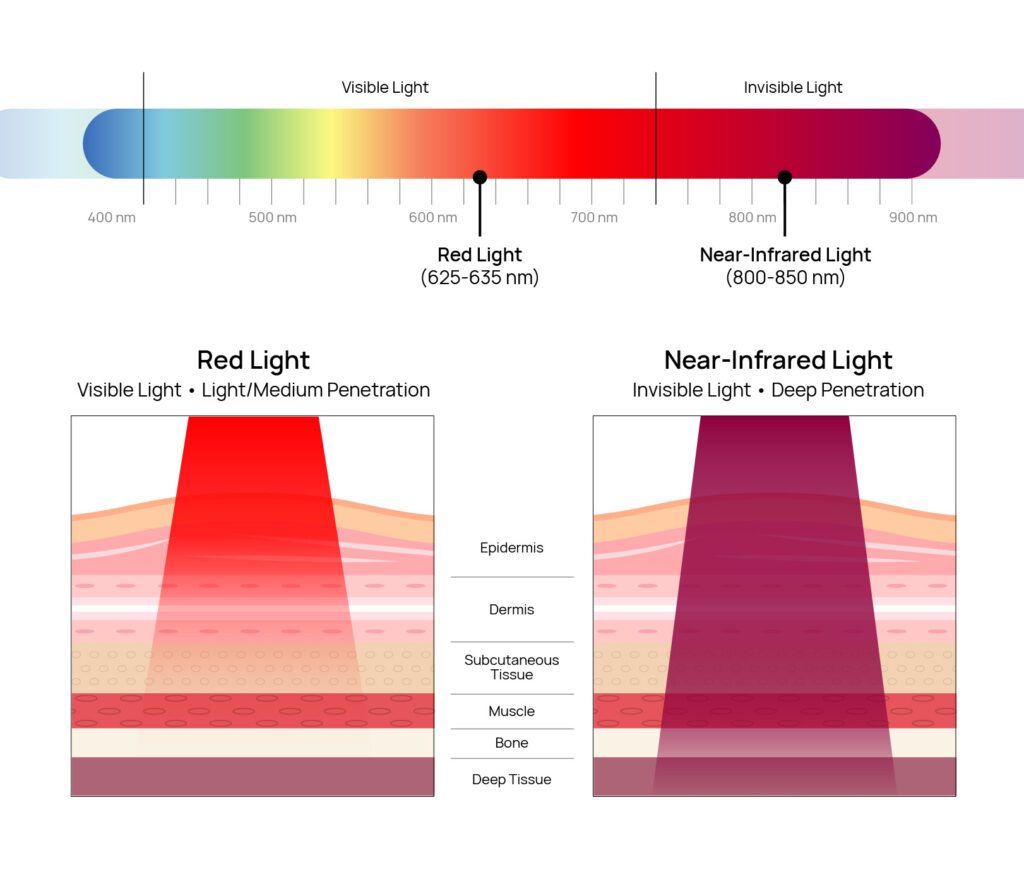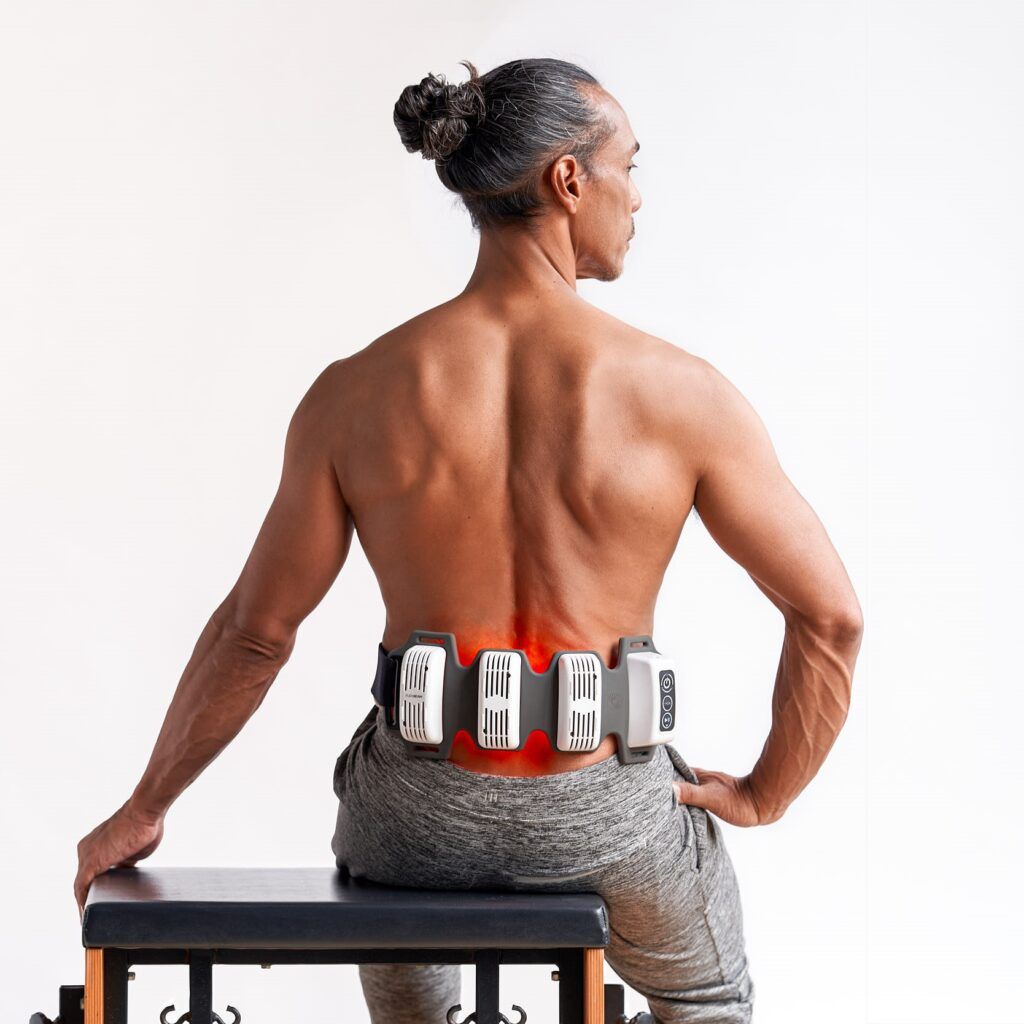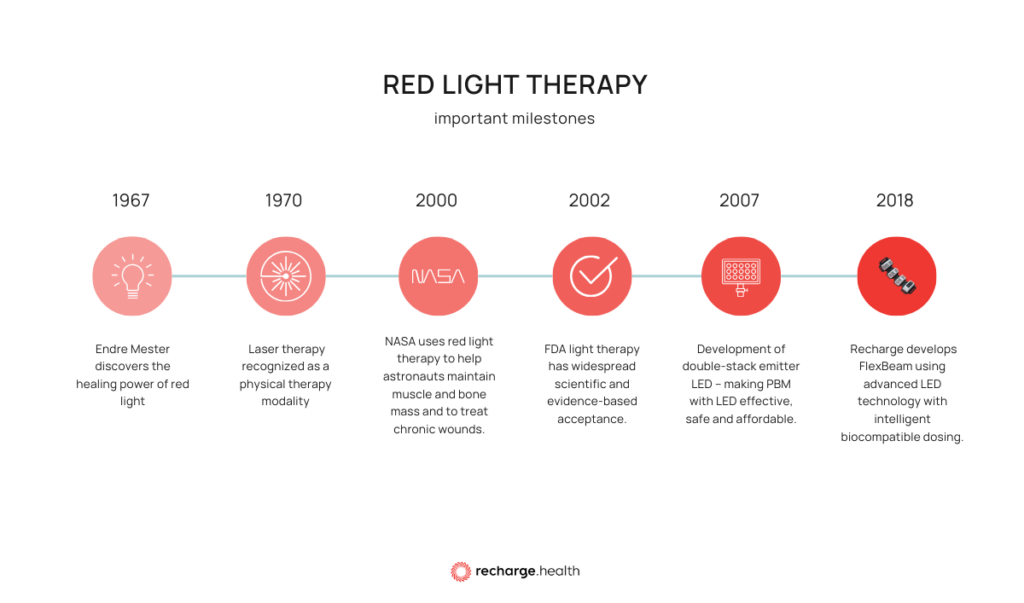Your cart is currently empty!
The Definitive Guide to Red Light Therapy
Why are we so drawn to dramatic views of dawn and dusk? Do you ever think about it?
Is it simply because of all the pretty colors? Is it because we tend to get solemn and philosophical about the new day and the inevitable passing of time? Maybe it’s the gentle, warm feeling when the red sun touches our face.
All of these are good reasons to be drawn to this special time, but that’s not all. We are drawn to the powerful healing effects of red light that the sun emits during these periods.
Sun exposure has great benefits. We have evolved in an outdoor environment and sunlight contains a broad range of wavelengths that vary at different times of the day. This is known as circadian biology and has a huge effect on our bodies.
That’s why we are naturally drawn to be out in the sun during periods in which we can benefit from this exposure the most – dawn and dusk.
Science has been engaged in research for decades in this field, finding evidence that our bodies are very sensitive to this light and that it can be applied for healing. Evidence is piling up and we have yet to discover precisely how we can use red light therapy for healing and wellbeing purposes.
This doesn’t mean we don’t already have significant knowledge on this subject. After all, this is precisely why we brought together a team of scientists and enthusiasts to create a portable red therapy device that you can use at home.
But for now, let’s dig deeper and explain how it all works.
Table of Contents
What Does Red Light Therapy Do for You?
Red light therapy (RLT) uses certain frequencies, irradiance, and energy density to supply your body with the energy it needs to heal itself and perform better.
What is red light therapy? – A light therapy with a primary goal to get your body healthy and strong so it can repair itself and overcome environmental challenges. Red light therapy has some amazing benefits. Among other things, red light therapy:
- Increases muscle endurance, tone, and density
- Improves cognition and lowers the risk of dementia
- Boosts healing of bones, tendons, and wounds
- Repairs damaged nerves
- Promotes hair health and growth
- Rejuvenates skin by strengthening the collagen network
- Improves immunity response
- Enables efficient communication of internal organs through the fascia
- Regulates hormones
- Helps improve and balance your mood
- Enhances your weight loss efforts
The mechanism behind red light therapy benefits is actually the electric charge that our bodies have naturally. Our bodies are charged positively or negatively on all levels. Our membranes, proteins, and even DNA are all charged.
Science shows that our body works like a big battery and light is what charges us.
What you really need to charge to trigger healing effects are your mitochondria – they are your cell organelles. Every cell has organelles and the number of mitochondria in a cell depends on the type of cell. For example, most mitochondria are found in the cells of the brain, heart, liver skin, ovaries, and muscles.
They generate so much energy and that is why they are needed in these vital organs. They are considered to be the powerhouse of the cell.
Besides generating energy, they also take care of signaling, cellular differentiation, regulation of the cell cycle, and growth.
So, how do you make sure your cellular powerhouses have all the energy they need?
Proteins within mitochondrial membranes can act as light receptors. This means that if you expose mitochondria to red light, those receptors will absorb the energy and increase the charge. Consequently, this leads to increased energy levels throughout the body.
Does Red Light Therapy Really Work?
Yes, it does. Red light therapy really works. It also has many names. If you ask what is red light therapy, you will get many answers. It is the umbrella term for all the treatments that you find under the names of photobiomodulation (PBM), low level laser therapy (LLLT), cold laser therapy, red infrared light therapy, red led lights therapy, and many more.
As long as the frequency of the light is between 600 nm and 850 nm, it is within the ranges of red and near-infrared light.
Red light therapy is a form of photobiomodulation backed by clinical research. If you browse Google Scholar for the term red light therapy, you will get over 3,050,000 results. Add to that almost 15,000 results for “photobiomodulation” and you’ll understand that this scientific field is definitely being deeply explored.
Here are some of them:
Photobiomodulation in Light of Our Biological Clock’s Inner Workings
Review of light parameters and photobiomodulation efficacy: dive into complexity
Benefits of Sunlight: A Bright Spot for Human Health
Proposed Mechanisms of Photobiomodulation or Low-Level Light Therapy
Is It Time to Consider Photobiomodulation As a Drug Equivalent?
NASA has been exploring the potential of red light therapy since the ‘80s and the interest for this type of non-invasive therapy has been growing ever since in the scientific community.
This research shows that photobiomodulation and low level laser therapy (that includes red light therapy) offers non-invasive alternatives to other light-based treatments. They don’t use ablation as a method of healing and there is no rise in temperature of the treated tissue. There are no UV rays, so it is not dangerous for the skin and it doesn’t cause sunburn.
Red light therapy can help relieve pain, soothe nerve injuries and improve wound healing.
While the research and the evidence pile up, it is always best to learn from personal stories and real-life examples. Our clinical director Dr. Zulia Frost experienced the effects of red light therapy herself. Here is her story:
While Dr. Zulia’s story is amazing, she is far from being the only one. Day by day, we get extraordinary feedback from people who are doing red light therapy at home. They are experiencing different red light therapy benefits and you can see them talking about their impressions on Recharge Health Youtube channel.
Both science research and the word of mouth are showing the same result – red light therapy benefits those that have suffered an injury, have acute or chronic pain, but also those that want to boost their wellness and fitness levels. Either way, red light therapy has systemic effects that truly help your entire body and mind function at an optimal level.
What Is Red Light Therapy Good For?
Red led light therapy is good for pain relief, repair, and recovery. The pain relief that red light therapy offers is achieved by increasing the blood flow so that the released endorphins can act faster and more efficiently. At the same time, the levels of nitric oxide are increased, which means better management of pain mechanisms.
The repair on the cellular level is a consequence of the mitochondria getting all the energy they need to speed up these processes. This energy from the red led light therapy is used for more efficient cellular regeneration. As a result, both cells and tissues heal faster and better. That’s why, wounds, for example, heal better when you use red and infrared light therapy.
Faster recovery, as one of the benefits of red light therapy, happens as a result of faster ATP production. When the ATP is produced due to energy that comes from red led light, it remarkably speeds up cellular regeneration. Also, this energizes the entire body.
Red and infrared light therapy do a fantastic job at giving your body enough energy that it allocates to the systems that need it the most in order for your body to stay healthy.
How does this all happen? The base of red light therapy benefits lies in its effects on the following systems:
- Fascia – the therapeutic effect of red light energy can be carried through the fascia network to other parts of the body where it is needed. This, in turn, elevates the body’s capacity to communicate via this charged matrix in a positive feedback loop.
- Gut-Brain Axis – the gut-brain axis links the emotional and cognitive centers of the brain with peripheral intestinal functions. Red light energy applied to the abdomen area can, therefore, influence mood and neuropsychological issues via several mechanisms.
- Immune System – beaming red light and near-infrared light onto cells creates a short, low-dose metabolic stress that builds up the cells’ anti-inflammatory, anti-oxidant, and natural defense systems, making the body stronger and more resilient to infections.
- Circulatory System – red light therapy has been shown to aid the function of the circulatory system and increases the microcirculation of blood – one of the most recognized and well-documented effects of this therapy.
- Nervous System – red light therapy benefits are being explored as a promising drug-free therapy for all kinds of nerve damage.
- Stem Cells – red light therapy is showing huge promise in current research to both stimulate growth of stem cells in the body, and to maximize the effect of stem cell implantation for a wide variety of medical purposes.
In other words, if you are trying to answer the question – what does red light therapy do, your answer will probably be along the lines of – almost anything you need.
What Are the Benefits of Red Light Therapy?
Red light therapy benefits your body on a molecular, cellular, and tissue level. The molecular level includes beneficial effects on calcium levels, melatonin, gene transcription, and other essential processes in your body.
The cellular level includes fighting off inflammation, boosting stem cell production, and migration among others.
Tissue benefits from red light therapy by becoming sturdier, more toned, and more dense. Brain and nerves are repaired and even your skin and hair get visibly healthier.
molecular
cellular
tissue
- Chromophores, cytochrome c oxidase, water, opsins
- Retrograde mitochondrial signalling
- Light-sensitive ion channels
- Adenosine triphosphate ATP
- Reactive Oxygen Species ROS
- Calcium
- Heat-shock proteins
- Melatonin
- Brain-derived neurotrophic factor
- Gene transcription factors
- Akt/mTOR/CyclinD1 pathway
- Inflammation
- Cytoprotection
- Proliferation
- Migration
- Protein synthesis
- Stem Cell production and migration
- Immune cell viability
- Retrograde mitochondrial signalling
- Transforming growth factor
- Pro- and anti-inflammatory cytokines
- Vascular endothelial
- Mitochondrial membrane potential
- Nerves: Repair and pain relief
- Healing: Bones, tendons and wounds
- Hair: Increases growth
- Skin: Improvement of collagen network, anti-aging, skin disorders
- Fat: Fat reabsorption improved by enhanced micro-circulation
- Lymph: Improved immunity
- Fascia: Communication, improved tensegrity
What Are the Side Effects of Red Light Therapy?
None. There are no known side effects. It is completely safe to use your device according to red light therapy instructions and enjoy your red light therapy at home.
When you are using your red light therapy device, you will feel it slightly warm up on your skin, but it should never be hot. Red led lights therapy and near infrared light therapy do not emit too much heat and their benefits aren’t based on temperature.
That is why this type of therapy is better for people that don’t tolerate high temperatures or have medical conditions that make them more sensitive to heat.
Additionally, there are no UV rays with red and near infrared LED light therapy. Your skin won’t be damaged by UV rays and you don’t need your sunscreen when you’re using your LED red light therapy devices. Also, forget about the aging effects the UV spectrum has on your skin. If anything, red light therapy for skin has shown amazing effects. It’s rejuvenating properties are a hit in the cosmetic industry.
However, there are situations in which you should be careful when using red light therapy. Consult your doctor before using your any form of red light therapy if:
- You are pregnant
- You have an active malignant disease
- You are undergoing chemotherapy
- You have highly photosensitive skin
- You take medication that makes your skin photosensitive
- You have thrombo-embolism or bleeding
- You have any acute systemic infections
- You have a heart condition
For many of these conditions, red light therapy has not shown any side effects of worsening of the existing symptoms. Still, not enough studies have been conducted to be absolutely sure about the effects of RLT on these conditions. Therefore, these are listed more as a precaution than as a result of negative effects being detected.
There are always individual differences to take into account, and nobody knows better than your doctor about the specifics of your health situation.
What Is the Difference Between Red Light Therapy and Infrared?
Many people are confusing red light therapy and infrared saunas. Infrared saunas use heat for their healing purposes, while LED red light doesn’t involve heat.
Red light therapy involves both red and infrared light. To be more precise, this is near-infrared light. The difference between red and infrared light is that they correspond to different wavelengths of light.

Red Light: Wavelengths ranging from 600 – 650nm. Red light boosts the formation of collagen and elastin and assists in cell communication. It penetrates superficially (up to 5mm) and is mainly used for skin conditions. Many devices aim to use 635nm red light therapy.
Near Infra-red (NIR) Lght: Wavelengths ranging from 750 – 850nm. NIR stimulates healing, increases mitochondrial function and improves blood flow and tissue oxygenation. It penetrates deeper into the body (up to 10cm).
FlexBeam covers both red and infrared light therapy It has 2 infrared light therapy LEDs and 1 red light LED in each light pod. This is a total of 6 LEDs with 810-850nm, and 3 at 625 – 635nm red light therapy LEDs.
How Often Can You Use Red Light Therapy?
It depends on the red light therapy dosing guide for the device you are using. Different devices offer different amounts of red light, so it’s difficult to give a general answer.
For FlexBeam, it is best if you use your device everyday or every second day. The rest day helps the therapy be more effective. The optimal length of each application is 10 minutes but it depends on the part of the body you want to treat and the type of issue you have. Sometimes, this will mean two or even three 10-minute applications. Your daily exposure should not go above 30 minutes a day.
There are no side effects to red light therapy, but excessive doses will diminish its effects. The right dose is crucial to the effectiveness of the treatments. If there is not enough exposure, the therapy is inefficient. If the exposure is too long, a habituation process is triggered and the therapy is not effective.
Another thing you should be aware of is how energy is delivered during photobiomodulation therapy. It is better to have 10-minute sessions every other day for a while than to try and have one two-hour long session. Just like how it makes a difference whether you drink a gallon of water in two minutes or two hours.
How Long Does It Take for Red Light Therapy to Work?
For deep-seated conditions, it can take weeks, for fresh injuries, days. This should be taken as an estimate as every body is different. Moreover, some subjects reported that they experienced feelings of relaxation and comfort immediately when using FlexBeam.
For example, FlexBeam medical team has developed a red light therapy dosing guide with two sets of protocols for each application. One is for those conditions that last for longer than 30 days and the other one is for those conditions that last less than a month.
Do You Wear Clothes During Red Light Therapy?
Yes and no – it depends on the red light therapy devices you are using. For panels and similar devices, you should not wear clothes on the body part that is exposed to the red light.
But, if you are using FlexBeam red light, you can wear your LED red light therapy device underneath your clothing. The idea is not to have a clothing barrier between the skin and the red led light.
So, do you wear clothes during red light therapy? You can if you’re using FlexBeam. Just don’t use it over your clothes.

FlexBeam has been designed to fit the human body. Its shape and flexibility enable more effective and targeted dosing because less power is needed to deliver energy directly to the affected site.
This allows light to penetrate deep into difficult-to-reach areas of the body – such as the knee and shoulder joint – which is impossible with flat light panels.
Our approach is also safer because it reduces unnecessary exposure of skin and surface tissue. Because FlexBeam is designed to be worn on the skin, each session yields a consistent dose and is not dependent on the distance from the light source.
In turn, this reduces treatment time, making it possible to deliver a targeted therapeutic dose in 10 minutes for a single placement.
How Long Has Red Light Therapy Been Around?
Red light therapy has been around since 1903. That year, the physician Niels Ryberg Finsen won the Nobel Prize in Medicine for his successful treatment of smallpox and lupus with red light.
Here is the timeline of important years in the development of red light therapy.
1967 – Researcher Endre Mester discovers the healing power of red light on a group of animals, testing to see if a laser could cause cancer. Not only did they not develop cancer, but the hair on the laser-treated group grew back faster than the untreated group.
1970 – By the early 1970s, laser therapy is recognized as a physical therapy modality in Eastern Europe, the Soviet Union, and China. In 1977, it appeared in the United States.
2000 – NASA uses red light therapy to help astronauts maintain muscle and bone mass and to treat chronic wounds.
2002 – FDA light therapy has widespread scientific and evidence-based acceptance.
2007 – Development of double-stack emitter LED – making PBM with LED effective, safe and affordable.
2018 – Recharge develops FlexBeam using advanced LED technology with intelligent biocompatible dosing for increased efficacy and ease of use.
2020 – Recharge global launch of FlexBeam.

Can You Do Red Light Therapy at Home?
Yes, you can! It has never been easier to do red light therapy at home. Now, you have the FlexBeam red light device.
The 3 preset programs in FlexBeam red light cover a variety of medical and wellness applications in one device. You can learn how to use red light therapy at home by following our red light therapy instructions. Each program lasts for 10 minutes, allowing for multiple target sites in one session.
| SURFACE PENETRATION DEPTH 0-2.5cm | Red 635nm NIR 810-850nm pulse | For conditions that are skin deep. A greater proportion of red light to near infra-red. |
| MEDIUM PENETRATION DEPTH 2.5-4cm | Red 635nm NIR 810-850 pulse | For smaller joints like the elbow, tissue, muscles and more. A mix of red and near-infrared. |
| DEEP PENETRATION DEPTH 4-10cm | Red 635nm NIR 810nm: CW (continuous wave) | For joints like knees and shoulders, and large organs like the liver. This preset has a predominance of near-infrared light. |
People usually associate red light therapy with red light beds in spas, clinics, and salons. FlexBeam doesn’t require you to book an appointment or wait for some free time to receive your therapy.
You now have the luxury of having your photobiomodulation treatment at your own home, anytime you like – While reading your morning paper even.
FlexBeam is a passion project. The people who created it are true believers in their work and the therapeutic properties of this device.
It’s easy to be a believer when you have the science to back up your ideas.
The creators of the FlexBeam developed and researched for 2 years before creating the final device. They did their homework, so you don’t have to.
Sources
NASA research illuminates medical uses of light | NASA spinoff. https://spinoff.nasa.gov/NASA-Research-Illuminates-Medical-Uses-of-Light
DeSmet KD, Paz D, Corry JJ, et al. Clinical and experimental applications of NIR-LED photobiomodulation. Photomedicine and Laser Surgery. 2006;24(2):121-128. doi:10.1089/pho.2006.24.121
Hamblin MR. Mechanisms and applications of the anti-inflammatory effects of photobiomodulation. AIMS Biophysics. 2017;4(3):337-361. doi:10.3934/biophy.2017.3.337
Mitochondria. Genome.gov. https://www.genome.gov/genetics-glossary/Mitochondria
The Editors of Encyclopaedia Britannica. Organelle | Cellular Structure, Function & Processes. Encyclopedia Britannica. Published February 6, 2009. https://www.britannica.com/science/organelle
Rosenberg LE, Rosenberg DD. Birth defects. In: Elsevier eBooks. ; 2012:241-258. doi:10.1016/b978-0-12-385212-0.00015-9
de Freitas LF, Hamblin MR. Proposed Mechanisms of Photobiomodulation or Low-Level Light Therapy. IEEE J Sel Top Quantum Electron. 2016;22(3):7000417. doi:10.1109/JSTQE.2016.2561201
Santana-Blank L, Rodríguez-Santana E. Photobiomodulation in Light of Our Biological Clock’s Inner Workings. Photomed Laser Surg. 2018;36(3):119-121. doi:10.1089/pho.2018.4445
Zein R, Selting W, Hamblin MR. Review of light parameters and photobiomodulation efficacy: dive into complexity. J Biomed Opt. 2018;23(12):1-17. doi:10.1117/1.JBO.23.12.120901
Mead MN. Benefits of sunlight: a bright spot for human health [published correction appears in Environ Health Perspect. 2008 May;116(5):A197]. Environ Health Perspect. 2008;116(4):A160-A167. doi:10.1289/ehp.116-a160
de Freitas LF, Hamblin MR. Proposed Mechanisms of Photobiomodulation or Low-Level Light Therapy. IEEE J Sel Top Quantum Electron. 2016;22(3):7000417. doi:10.1109/JSTQE.2016.2561201
Karu T. Is it time to consider photobiomodulation as a drug equivalent?. Photomed Laser Surg. 2013;31(5):189-191. doi:10.1089/pho.2013.3510
